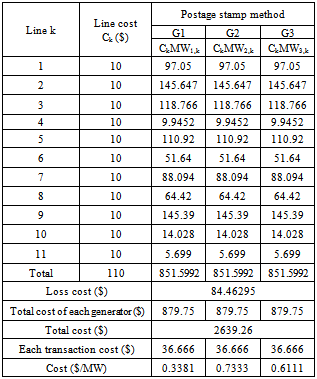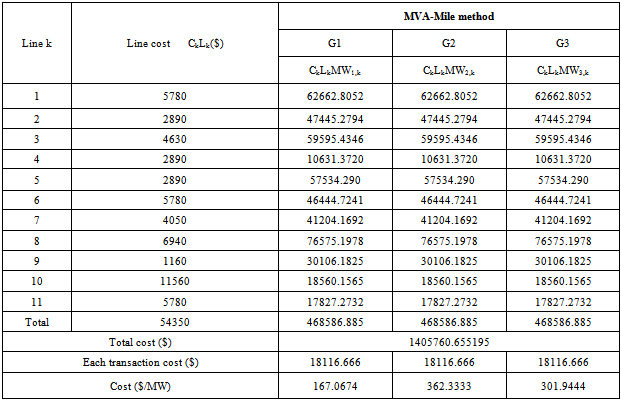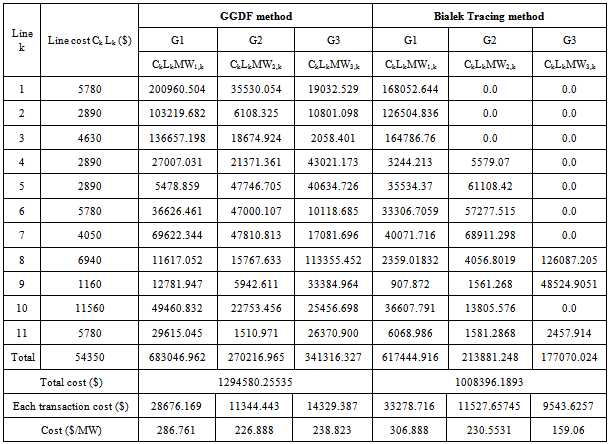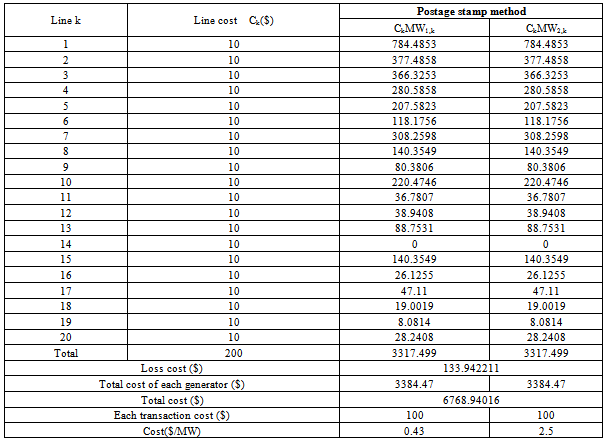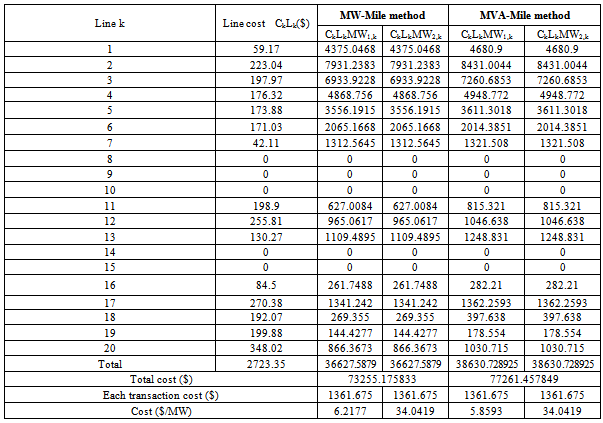-
Paper Information
- Paper Submission
-
Journal Information
- About This Journal
- Editorial Board
- Current Issue
- Archive
- Author Guidelines
- Contact Us
Electrical and Electronic Engineering
p-ISSN: 2162-9455 e-ISSN: 2162-8459
2011; 1(1): 33-41
doi:10.5923/j.eee.20110101.06
A Comparison of Fixed Cost Based Transmission Pricing Methods
M. Murali , M. S. Kumari , M. Sydulu
Electrical Engineering Department, National Institute of Technology, Warangal, 506004, India
Correspondence to: M. Murali , Electrical Engineering Department, National Institute of Technology, Warangal, 506004, India.
| Email: |  |
Copyright © 2012 Scientific & Academic Publishing. All Rights Reserved.
In the restructured power market, it is necessary to develop an appropriate pricing scheme that can provide the useful economic information to market participants, such as generation, transmission companies and customers. Proper pricing method is needed for transmission network to ensure reliability and secure operation of power system. Accurately estimating and allocating the transmission cost in the transmission pricing scheme still remains challenging task. This paper gives an overview of different costs incurred in transmission transaction, types of transmission transactions and the transmission pricing methodologies. Embedded as well as Incremental cost methods are explained. It mainly focussed on determining the embedded transmission cost by various methods and compared the results for 6bus, IEEE 14bus and RTS 24 bus systems.
Keywords: Bialek Tracing, Embedded Cost, GGDF, MVA-Mile, MW-Mile, Postage Stamp, Tracing
Cite this paper: M. Murali , M. S. Kumari , M. Sydulu , A Comparison of Fixed Cost Based Transmission Pricing Methods, Electrical and Electronic Engineering, Vol. 1 No. 1, 2011, pp. 33-41. doi: 10.5923/j.eee.20110101.06.
Article Outline
1. Introduction
- The rapidly changing business environment for electric power utilities all around the world has resulted in unbundling of services provided by these utilities. With the introduction of restructuring into the electric power industry, the price of electricity has become the focus of all activities in the power market. The objective of transmission pricing is to recover all or part of the existing and new cost of transmission system. Pricing of transmission services plays a crucial role in determining whether providing transmission crucial role in determining whether providing transmission services is economically beneficial to both the wheeling utility and the wheeling customers. Engineering analysis which deals mainly with determining the feasibility and the cost of providing transmission services is only one of many considerations in the overall process of pricing transmission services. So, it is important to distinguish between transmission costs and prices.
1.1. Categories of Transmission Transactions
- The following are the categories[2,3] of transmission transactions:
1.1.1. Firm Transmission Transactions
- These transactions are not subject to discretionary interruptions and are specified in terms of MW of transmissioncapacity that must be reserved for the transaction. The transco makes arrangements for enough capacity on the network to meet these transaction needs. These could either be on a long-term basis, in the order of years or on short-term contracts (up to one year).
1.1.2. Non-firm Transmission Transactions
- These transactions may be curtailable or as-available. Curtailable transactions are ongoing transactions that may be curtailed at the utility's discretion. As-available transactions are short-term, mainly economy, transactions that take place when transmission capacity becomes available at specific areas of the system at specific times.
1.1.3. Long-term Transmission Transactions
- A long-term transaction takes place over a period spanning several years. Long-term transmission transaction is long enough to allow building new transmission facilities. Transmission service provided as part of long –term firm power sales is an example of long-term transaction[3].
1.1.4. Short-term Transmission Transactions
- A short-term transmission transaction may be as short as a few hours to as long as a year or two and as such are not generally associated with transmission reinforcements. Short term transaction may be a bilateral contract or pool trading[3].
1.2. Components of the Transmission Cost
- The major components of the transmission cost of transmission transactions are:[17]
1.2.1. Operating Cost
- This is the cost due to generation rescheduling and redispatches to minimize the system losses, relieve congested transmission lines and enhance the system voltage profile.
1.2.2. Opportunity Cost
- Benefits of all the transactions that the utility forgoes due to operating constraints. It is defined as costs that may be encountered in the transmission constrained case where the wheeling may prevent the transmission capacity. In other words it is the profit obtained to ISO during congestion in the system.
1.2.3. Reinforcement Cost
- Capital cost of new transmission facilities needed to accommodate the transaction. It also includes the installation of additional reactive power resources to support the transaction.
1.2.4. Embedded Cost
- The allocated cost of existing transmission facilities used by the transmission transaction. It includes:Investment costs (including returns and depreciation of capital equipment) which is the highest proportion of the overall cost. Administrative and general costs including scheduling and coordination services, billing and accounting staff, and salaries.Investment for operation and maintenance costs.Cost of voltage control and reactive power support.Operating cost, opportunity cost and reinforcement cost constitute the incremental cost of the transmission transaction. Incremental costs are two types. They are short run and long run incremental costs. "Short-Run Incremental Cost" refer to operating cost and opportunity cost, "Long-Run Incremental Cost" refers to operating cost, opportunity cost and reinforcement cost. "Congestion Cost" is also called opportunity cost and "Embedded Cost" is also called existing system cost.
2. Transmission Pricing Methods
- The main objective of any transmission pricing method is to recover the transmission system cost plus some profit. Transmission pricing methods are the overall processes of translating transmission costs into overall transmission charges. These methods are shown in Figure 1:
 | Figure 1. Different transmission pricing methods |
2.1. Incremental Transmission Pricing
- These pricing methods allocate the incremental cost (i.e., variable cost) of the transmission transaction. Figure 2 shows different types of incremental pricing methods.
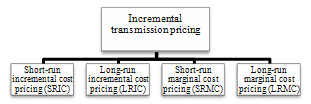 | Figure 2. Types of incremental transmission pricing methods |
2.1.1. Short-run Incremental Cost Pricing (SRIC)
- This pricing methodology entails evaluating and assigning the operating costs associated with a new transmission transaction to that transaction. The transmission transaction operating costs can be estimated using an optimal power flow (OPF) model that accounts for all operating constraints including transmission system (static or dynamic security) constraints and generation scheduling constraints.
2.1.2. Long-run Incremental Cost Pricing (LRIC)
- This pricing methodology entails evaluating all long-run costs (operating and reinforcement costs) necessary to accommodate a transmission transaction and assigning such costs to that transaction. The reinforcement cost component of a transmission transaction can be evaluated based on the changes caused in long-tem transmission plans due to the transmission transaction.
2.1.3. Short- run Marginal Cost Pricing (SRMC)
- The short-run marginal cost of a Transco is the cost of supplying an additional 1 MW of power in a transaction. SRMC is the difference in marginal costs of supply bus and delivery bus. The marginal costs of two buses can be determined from the optimal power flow solution as the dual variables associated with the demand balance equation. The transaction price can be determined by multiplying the power transaction with the SRMC to obtain SRMC based price.[4,5,6,7] SRMC takes into consideration the variable costs incurred by the transaction i.e., the operating cost but not the reinforcement cost.
 | (1) |
2.1.4. Long-run Marginal Cost Pricing (LRMC)
- LRMC determines the present value of future investments required to support a marginal increase in demand at different locations in the system, based on peak scenarios of future demands and supply growth[8]. In this pricing methodology the marginal operating and reinforcement costs of the power system are used to determine the prices for a transmission transaction.
2.2. Embedded Transmission Pricing
- These pricing methods allocate the embedded system costs i.e., fixed cost among transmission system users. Embedded pricing methods can be categorized as in Figure 3:
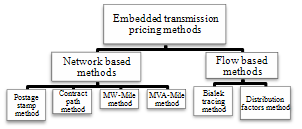 | Figure 3. Types of embedded transmission pricing methods |
2.2.1. Network Based Methods
- These methods depend on the structure of the transmission system but do not recognize the physical laws governing its operation[8]. a) Postage Stamp MethodPostage-stamp rate method is traditionally used by electric utilities to allocate the fixed transmission cost among the users of firm transmission service. This method is an embedded cost method, which is also called the rolled-in embedded method. This method does not require power flow calculations and is independent of the transmission distance and network configuration. The magnitude of the transacted power for a particular transmission transaction is usually measured at the time of system peak load condition:
 | (2) |
 | (3) |
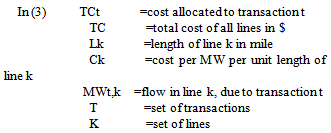 d) MVA-Mile MethodThe MVA-Mile method is an extended version of the MW-Mile method. It takes into consideration both real power and reactive power where as MW-Mile method considers only real power. This method also allocates the transmission charges based on the magnitude of power and the geographical distance between the delivery point and the receipt point. This method is AC power flow based method.
d) MVA-Mile MethodThe MVA-Mile method is an extended version of the MW-Mile method. It takes into consideration both real power and reactive power where as MW-Mile method considers only real power. This method also allocates the transmission charges based on the magnitude of power and the geographical distance between the delivery point and the receipt point. This method is AC power flow based method.2.2.2. Flow Based Methods
- This approach allocates the charges of each transmission facility to a wheeling transaction based on the extent of use of that facility by the transaction. This is determined as a function of magnitude, the path, and the distance travelled by the transacted power. The flow based methods are Bialek tracing method and Distribution factors method.a) Bialek Tracing Method This algorithm works only on lossless flows when the flows at the beginning and end of each line are the same. The simplest way of obtaining lossless flows from the lossy ones is by assuming that a line flow is an average over the sending and receiving end flows and by adding half of the line loss to the power injections at each terminal node of the line[14].The total flow Pi through node i (i.e., the sum of inflows or outflows) may be expressed, when looking at the inflows as[15]
 | (4) |
 an unknown gross line flow in line i-j
an unknown gross line flow in line i-j = an unknown gross nodal power flow through node i
= an unknown gross nodal power flow through node i = upstream distribution matrixPGk = generation in node k
= upstream distribution matrixPGk = generation in node k = set of nodes supplied directly from node i
= set of nodes supplied directly from node i = set of buses supplying directly to bus ib) Distribution Factors MethodDistribution factors are calculated based on DC load flows. These factors are used to determine the impact of generation and load on transmission flows. The various distribution factors are Generation shift distribution factors (GSDF’s) and Generalized Generation/ load distribution factors (GGDF’s/GLDF’s) have been used extensively in power system security analysis to approximate the transmission line flows and generation /load values. GSDF’s or A factors provide line flow changes due to a change in generation. These factors can be used in determining maximum transaction flows for bounded generation and load injections. GGDF’s are applied to estimate the contribution by each generator[15,16] to the line flow on the transmission grid and GLDF’s determine the contribution of each load to line flows.
= set of buses supplying directly to bus ib) Distribution Factors MethodDistribution factors are calculated based on DC load flows. These factors are used to determine the impact of generation and load on transmission flows. The various distribution factors are Generation shift distribution factors (GSDF’s) and Generalized Generation/ load distribution factors (GGDF’s/GLDF’s) have been used extensively in power system security analysis to approximate the transmission line flows and generation /load values. GSDF’s or A factors provide line flow changes due to a change in generation. These factors can be used in determining maximum transaction flows for bounded generation and load injections. GGDF’s are applied to estimate the contribution by each generator[15,16] to the line flow on the transmission grid and GLDF’s determine the contribution of each load to line flows.3. Results
- Tables 1 to 8 present the cost of one MW generation for each generator using various pricing methods applied to 6 bus system, IEEE-14 bus system and RTS 24 bus systems. 6 bus system[19] has generators at bus numbers 1, 2, 3. In this paper line lengths are assumed to be proportional to the line reactance. For transformers line lengths are neglected and are taken as zero. Postage stamp method doesn’t consider system line lengths, and hence gives a very inferior result compared to other methods. MW-Mile method uses DC power flow solution and accounts for line lengths. MVA-Mile method uses AC power flow and also accounts for the line lengths. GGDF method uses DC power flow and Power transfer Distribution factors for pricing and traces the actual power flow of each line by each participant. Bialek tracing method uses AC power flow algorithm and it also traces the actual power flow of each line by each participant. The results shows that, power flow tracing based methods present more accurate pricing compared to postage stamp method, MW-Mile method and MVA-Mile method. Tables 1, 2, 3, 4 illustrates cost per MW generation for each generator using various methods for 6 bus system Tables 5, 6, 7 illustrates cost per MW generation for each generator using various methods for IEEE-14 bus system[18] which has Generators at bus numbers 1, 2.Flow based Bialek tracing method is the best way of transmission pricing, which considers AC power flow and total line flows. Table 8 demonstrates the results obtained for RTS 24 bus system[20] containing 10 generators. In all the methods for all bus systems transmission charges are allocated to generators only.
|
|
|
|
|
|
|
|
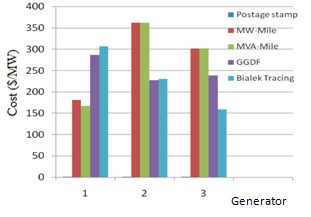 | Figure 4. Comparison of 6 bus system results for different methods |
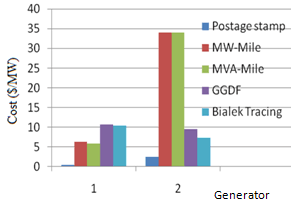 | Figure 5. Comparison of 14 bus system results for different methods |
 | Figure 6. Comparison of 24 bus system results for different methods |
4. Conclusions
- In this paper embedded cost based methods of transmission pricing have been discussed. Different cost components incurred by the transmission transaction were explained. Case studies of postage stamp method, MW-Mile method, MVA-Mile method, Distribution factors method and Bialek tracing method for 6bus, IEEE14bus and RTS24 bus systems are presented. Postage stamp method for calculating embedded cost provides a very inferior solution compared to other network based and flow based methods. Bialek tracing method is the best way of transmission pricing, among all embedded cost based methods. It is observed that combination of incremental and embedded cost based methods could result in the recovery of true transmission system costs.
ACKNOWLEDGEMENTS
- I wish to acknowledge my colleague Rakesh Chandra who helped me a lot in doing this work.
 Abstract
Abstract Reference
Reference Full-Text PDF
Full-Text PDF Full-text HTML
Full-text HTML